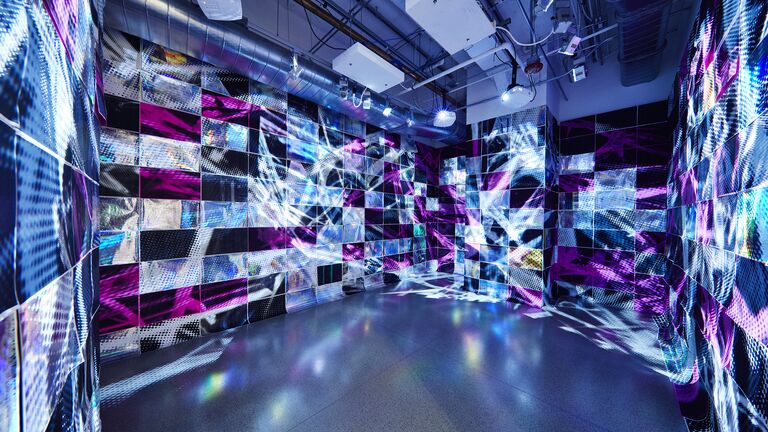
© 2017 School of the Art Institute of Chicago; All Rights Reserved Artwork: Maria Burundarena
Students
First-Year Graduates
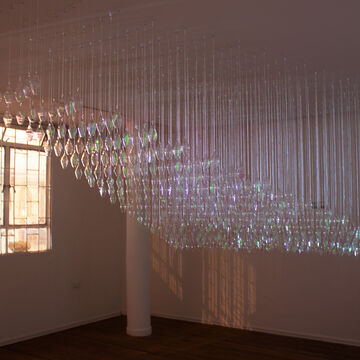
Sofía Paredes Vélez
Sofía Paredes Vélez
Sofía Paredes Vélez, artist from Bogotá, Colombia.
My work focuses on the construction of individual or collective spaces through the exploration of diverse materials and the creation of momentary, fleeting installations. These woven spheres intend to accentuate transitions: physical as well as emotional, and culminate in building a terrestrial place, not only for me and those around me, but also for those who are absent, for what no longer exists, what has been lost or has changed. To try to catch and contain what is gone without, at the same time, denying those endings.
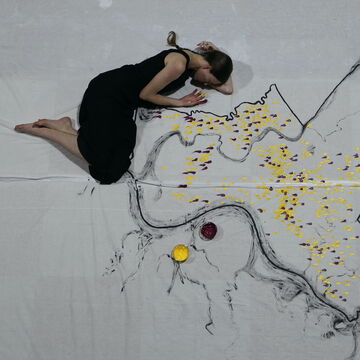
Kately Towsley
Kately Towsley makes work about the human experience. She is interested in memory, collective and individual narratives, and our connection to one another and the places we inhabit. Towsley frequently utilizes fiber, ceramics, and botanical matter in her performances and installations, allowing the concept to guide her material decisions.
Towsley's work is a product of personal learning and exploration. Her work is an investigation seeking to educate and commemorate: a making in response to questions she has, musings, reflections, convictions, or realizations that she does not know enough about a critical history, or current event. There are times Towsley makes in order to document, others to help her spiritually or emotionally process, and others still where her work is a ritual—an act of making inspired by grief, mourning, awe, remembrance, appreciation, joy.
Towsley treats the process of making as a time of contemplation, sometimes worship. Her work shares personal inspection while provoking the viewer’s own thoughts, experiences, knowledge, or lack thereof on a subject. She favors methods that are detail-oriented, tedious, and involved in order to imbue the work with a greater sense of intention and presence.
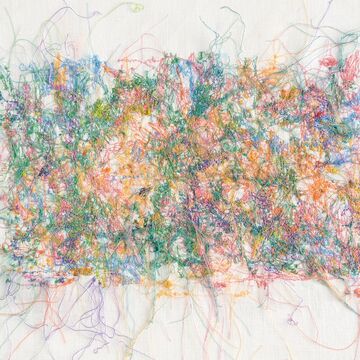
Talia Newman
I'm an interdisciplinary artist from Toronto (Tkaronto), Canada living in Chicago. Currently, I am experimenting with fibrous textures and a chaos of colours to explore escapism, destructive calm, coping gone awry, energy and stasis, comfort, fun, and anxiety.
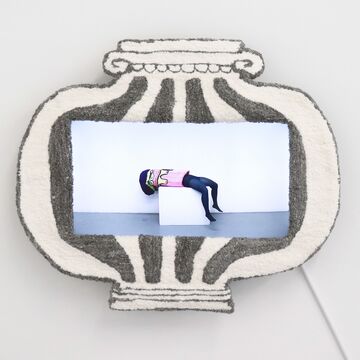
Cat Bowyer
Cat Bowyer is an multidisciplinary artist who has been working and living in Chicago for almost 10 years. Her work utilizes a variety of materials where the body is usually included in the foundation of ideas. She holds a BA from Purdue University in Fine Art & Visual Art Education.
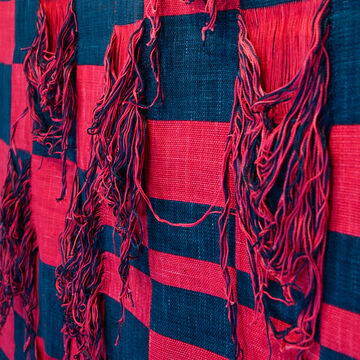
Lauren Stichweh
Lauren Stichweh (they/she) is a multidisciplinary fiber artist from northeast Georgia whose practice embarks on an exploration of identity, connection, and community. Intertwining personal experience and emotion with supplemental research, they weave (and destruct) narratives that delve into the complexities of human relationships. Their work is driven by the idea of the existence of threads that we share throughout our lives and metaphorically weave together, leaving behind inextricable connections. Through slow, repetitive processes such as weaving, knitting, wrapping, and stitching, their work seeks to tangibly explore and test the limits of the interactions between these intangible threads of connection.
From quantum entanglement; the phenomenon of two particles remaining linked regardless of the distance between them, to unbreakable relationships that exist across the world, the premise of a “loose end” is a practical fallacy when we examine the context of each part of ourselves. The particles found in quantum mechanics are mimicked in human behavior, we can never fully separate from those with whom we have been intertwined. We may break ties, but the impression left upon us never fully fades. There may be endless space between us, but the link remains, ultimately removing us from ever fully becoming a solitary entity.
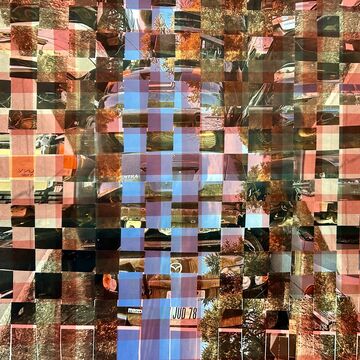
Tommy Ballard
Tommy Ballard is an artist, writer, and educator from the Ohio River Valley. Text/textile processes are utilized as research for topics including contemporary and manufactured material culture, ontology, art education, critical craft, commodification, mechanical reproduction, sentimentality, print media and the US Rust Belt region.
Ballard has an MA in Art Education and BFA in Creative Writing from the Art Academy of Cincinnati and has collaborated with organizations and institutions including the Contemporary Art Center, Dayton Art Institute and the Cincinnati Art Museum. They lead an artist-run space, Material Culture Collection, in Newport, Kentucky and work as an educator in community and academic environments for students of all ages and abilities.
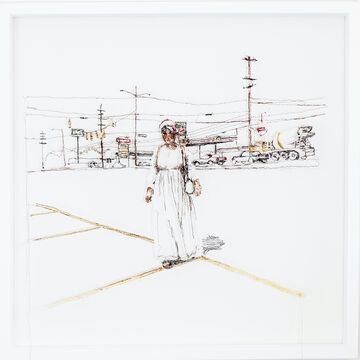
Beizar Aradini
Beizar Aradini is a fiber artist whose practice centers on themes of home, displacement, collective memory, and storytelling. Her work reveals the intricacies of the immigrant experience, often shaped by the lingering impacts of imperialism and colonialism. Through intimate depictions of family, shared memory, migration, and liminal spaces, she highlights the interconnectedness of these experiences, shedding light on stories that are too often neglected or erased.
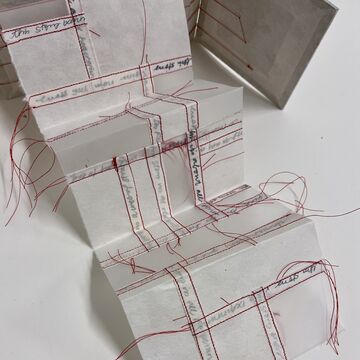
Dagny Chika
Dagny Chika (they/she) is an artist, writer, and educator from the Pacific Northwest. She uses fiber processes such as knitting, book-making, sewing, quilting, and tapestry weaving to create playful, whimsical, and ethereal objects. They engage with materiality and the moment-by-moment processes of making to explore mixed identities and vast emotional landscapes.
Her practice is often guided by reflection and intuition, and thus they often find greatest inspiration in deeply personal materials: journal entries, clothes handed down by family, and other artifacts from childhood. With an educational background in literature and creative writing, she often utilizes text—poetry and memoir—as material as well. They are left-handed and have a sweet tooth.
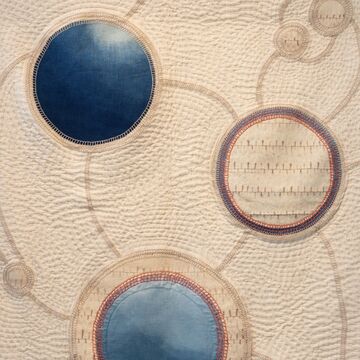
Kristin Field
Kristin Field is a textile artist, natural dyer, and gardener based in Chicago, IL. Her practice is rooted in research, sustainability, and honoring the craft of artisan natural dyeing traditions. She is interested in the intersection between art and science and inspired by the wonder found in the micro to the macro, from cicada wings to black holes. Her work is largely process and materials based, and she grows much of her own dye plant material in Chicago. She cherishes the slowness that is required to notice the intricacies and small beauties in the ephemeral, routine, or discarded, and seeks to give attention and recognition to the overlooked. Her work values and expresses curiosity, truly noticing the details in the world around you, and an understanding that there is always more to know.
Gabriele Irle
Jess Xing
Second-Year Graduates

Alanna Huck-Scarry
Alanna Huck-Scarry
I find inspiration in Nature and the human body: the dense midwestern prairie, the chartreuse of city-pond greens, the vastness of the Lake Michigan horizon, but also, in the similarities between my curved hips and the gentle bend of a sand dune’s summit; the impermanence of physical imperfections and the impermanence of a budding spring flower. In my work I try to find connections between my body and the world in which I live in hopes of exploring greater existential questions about both.
My process is impacted by the certainty and uncertainty inherent in collaborating with Nature. Materials such as natural dye can be temperamental; the dye bleeds, the colors shift, and hours (or days) later the result is a totally different image. My joy in watching the natural world around me is in its unpredictability, and nothing closer matches that, in my opinion, than the unpredictability of the changing body. At the same time, I find joy in the knitting of an acorn-dyed tapestry that echoes the predictable repetition I might find in radially patterned coneflower petals. In my work, I try to honor the certainty of Nature’s cyclical rhythm while also finding harmony in Nature’s impermanence by incorporating both in my process.
The certainty and uncertainty that exist in both my body and the natural world is something I find endlessly fascinating and mysterious. Exploring both subjects through my practice I find ways in which they intersect and influence one another. The connections help me better understand myself.

Galería La Cometa
Gabriela Estrada Loochkartt
Gabriela Estrada is a Latin American, ecofeminist woman. Inhabiting her territory is the seed of her work. She built an unusual house, a nest with breathing walls, where inner life is born in conversation with the mountain that holds it. In her work she seeks to approach the earth from listening, not from imposition, because nature has been exploited by patriarchy as a capital that endlessly feeds the man. She is a bird woman who weaves her house and offers it to the earth.
Gabriela takes her house to other places and opens questions on how we have inhabited the world and on how we may do it from care and awareness. She weaves houses to remind us that we must curl up, as we once did in the uterus, our first house, but this time in the earth, which is also a sacred feminine womb where we are protected and which we must protect. The mountain, the house, and the uterus are grandmothers and mothers.
Gabriela honors the mountain as a body. Weaving the mountain allows her to be inside of her and to carry her skin. Weaving her is watching over her memory so that it remains unerasable.

Ellie Anderson
Ellie Dale Anderson
Ellie Dale Anderson is a fiber and sculpture artist from Michigan. Through familial traditions, memories, and scientific findings she works to explore the ever vast relationship we hold with the natural world. Through walking and gathering materials to incorporate into her pieces, she creates an ecosystem of found objects and memories. By looking at the past lives of these materials she reimagines a new future. Common objects such as rocks, sticks, broken glass, seed pods and grocery bags are transformed. By changing common materials she contemplates new ways to envision our world and the fragility of its systems. In the process of making these ecosystems, objects are wrapped, dipped, and woven together. She sees wrapping and weaving these materials together as an act of care towards the object in hopes of preserving it. In the process of making she reflects on stillness, gesture, and the act of mending. Common source imagery that informs her practice comes from cellular structures of plants that she holds childhood memories with. She is fascinated by these molecular structures and their similarities between woven thread. Together she sees her work as a site where a patched collection of interconnected moments can coexist.

Lauren Bradshaw
Theo Trotter
My work references the trans body as a palimpsest, through the marks of transformation and trauma that manifest on it. It deals with the idea of transformation as a necessary and transcendent, but simultaneously painful experience by utilizing the tension between beautiful and disgusting visual elements. This conflict between attraction and repulsion also represents injury and healing. I address visceral bodily experiences at the point where language begins to fail, dealing with, among other things, physical harm to the body, and the injury of forced femininity.
I utilize a variety of different media including textiles and latex. What many of my materials have in common is a pliability and vulnerability that mimics the flesh. I am drawn to other materials, such as lace, because of the closeness and intimacy to the skin that they evoke. Touch is an essential part of my process, and sometimes remains visible in the work as imprints in the materials. I am always in conversation with the materials, at once injuring or harming them, and allowing their nature to shape the trajectory of my work.

Bishal Manandhar
Bishal (Bhaikaji) Manandhar
Bishal Manandhar is a visual artist who sees the value, potential, and richness in the unseen and discarded objects around us. Anything, that is overlooked in people’s lives and is treated as “waste” becomes the starting point of Manandhar’s art practice. As a Nepali immigrant, Manandhar was in shock when he moved to the USA and saw how much stuff people use and throw away. While growing up, everything was used until it stopped functioning or was used up. Reuse was a survival strategy, not just an environmental concern. Coming from this background, Manandhar came to see “trash” as something full of beauty and life. He does not see them as lifeless objects, but objects with a voice and a new hidden use; the ability to be something that brings us aesthetic pleasure.
After seeing the waste produced in the US, Manandhar was compelled to use it in his art rather than consuming new materials. He recycles existing materials, including discarded burlap rice bags, tea and coffee packaging, plastics, tea bags, soda cans, and milk cartons into visually captivating art works. Another part of Manandhar’s practice is the act of collecting all these objects either from his own home, friends, or the restaurants he has worked at. Once he has obtained the materials, everything is sent through various transformations, a process which brings great joy. His artistic practice creates new art pieces through repetition, juxtaposition, and the building of unusual textures by layering, melting, stitching, sewing, and stacking materials together.

Merryn Omotayo Alaka & Sam Frésquez
Merryn Omotayo Alaka
Merryn Omotayo Alaka (b. 1997, Indianapolis, Indiana) is a Nigerian and American artist who holds a BFA in printmaking from Arizona State University, Tempe, AZ. Alaka's applied creative practice has been intuitively rooted in an exploration of collective memory and identity with a curiosity for how the histories of the Black diaspora are preserved and reproduced. Through themes of ritual, mythology, transformation, and bodily autonomy, she conceptualize safe spaces as a necessary strategy for passing on intergenerational imagery, narratives, and traditions for a people who's histories are constantly erased, misrepresented, and misinterpreted. Materiality and cultural ephemera within her work serve as vessels chronically personal or collective experiences, concentrated on Black queer subjectivity. Alaka uses hair materials and adornments, textiles, fibers, and woodworking along with craft based processes tied to the African diaspora as a way to connect with both past and future generations. Pattern making has served as an integral component of her work as a non verbal visual language and metaphor for the repetition of knowledge and traditions continually passed down.
Omotayo Alaka has exhibited at institutions including the Phoenix Art Museum, Tucson Museum of Art, Scottsdale Museum of Contemporary Art, and. Omotayo Alaka is the recipient of the 2022 Lehman Emerging Artist Grant from the Phoenix Art Museum. Merryn Omotayo Alaka currently lives and works in Chicago Illinois , her work is represented by Lisa Sette Gallery.
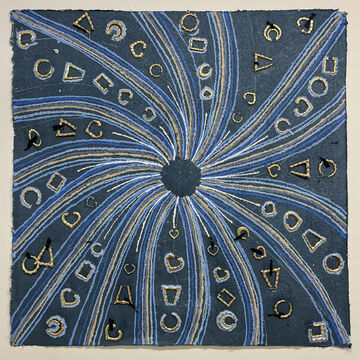
Aidan Anne Frierson
Aidan Anne Frierson is an Artist and Educator working with memory, place, and space by way of pattern, color, and specific material relevant to her life, such as Cotton. Other fiber & materials of interest and impact include metal, clay, skin, and writing.
Her practice, primarily rooted in Handmade Papermaking, prioritizes Cotton as the material reason that answers the pertinent question, “Why Are We Here?” Cotton serves as a vessel for Frierson to physically process what is lived and what is felt.
Through Handmade Papermaking, Frierson associates her relationships with people, place, and experience by engaging with color, texture, size, pattern and form. Frierson investigates form by physically embedding remnants and material motifs that represent life, place, and narrative; this process honors history as material.
Frierson’s work is a contemporary retrospective rooted in living, feeling, autobiography, and archive; She reflects on both personal and collective experiences of identity, people, and place from interconnections of the past, present, in-between and in-beyond. Frierson’s work is a culmination––a form––of material storytelling and diaristic cartography that reflect memory’s interdependent relationship with reality.
Frierson’s public programming, education work, and cultural practice has shown up collaboratively in spaces such as: Hyde Park Art Center, Chicago Public Schools, The GREYSTONE Collective, Chicago Park District, Chicago Torture Justice Center, Chicago Art Department, University of Illinois at Chicago Montgomery Ward Gallery, Marwen, Time Being Tattoo, Flower World Tattoo, Dieu Donné, Hook Pottery & Paper, Sitter Studio NYC, Smart Museum of Art, and Penland School of Craft.
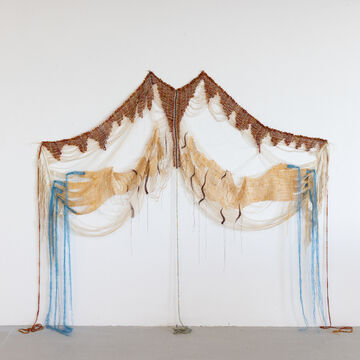
Lydia Daniller
Adrienne Weiss
Adrienne Weiss is a multidisciplinary fiber artist and educator whose practice is rooted in the understanding that corporeal awareness, research, ritual, dreams, activism, and art-making are interdependent phenomena that work together in service of personal and collective liberation. She got her B.A. in Art History and American Studies at UC Berkeley in 2005 and was a Bay Area public school educator for 15 years.
Adrienne’s work lives in a world of wild queer mysticism. It is a sensual and earth-facing investigation of the ecological realities of identity, embodiment, and direct experience. She combines weaving, sculpture, and ritual performance in ways that evoke our sacred and playful relationships to the ground and the heavens. She is interested in the life of intersecting lines, the metaphors they conjure, and finding a balance between manipulating them and letting them move in their own mystical ways. Adrienne utilizes the visual language of dreams, visions, lineage, animals, and symbolism to create a woven world of talismanic art.
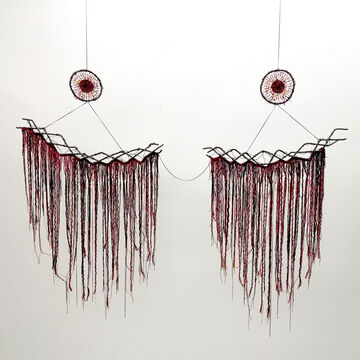
Krista Chalkley
Krista Chalkley
Krista Chalkley (they/them) is an interdisciplinary artist working primarily within the mediums of fiber, installation, and movement to explore themes of fluidity, interconnection, embodiment, and regeneration. Their work considers gender as a spiritual practice– one that is in service of traversing the inherently queered boundaries that compose all elements of our natural and metaphysical worlds. Intertwined environments take shape and converge with the corporeal, investigating thresholds of land, body, spirit, and collective. Interactive fiber works become suspended in air through a structuring system of ropes and pulleys, translating the viewer’s expressive gestures into ephemeral, mercurial forms. Through this interaction, the work seeks to understand how energy is passed from one vessel to the next, and how the vessel might act as a conduit for discovering one’s own agency through the subversion of its systemic parameters.
Chalkley (b.1994, Dallas, TX) received their BA in Visual and Performing Arts from The University of Texas at Dallas. Their work has been exhibited at venues such as Art League Houston, Oak Cliff Cultural Center, Arts Fort Worth, and the AT&T Showcase gallery in the Dallas Discovery District. In 2022, they were awarded the Arch and Anne Giles Kimbrough grant by the Dallas Museum of Art in support of their practice. Currently, Chalkley lives and works in Chicago, IL while pursuing their MFA in Fiber and Material Studies at the School of the Art Institute of Chicago.